Book contents
4 - Gender, Generation and the Production of Locality in the Diasporic Family
Published online by Cambridge University Press: 05 September 2013
Summary
In modern globalised societies, a world of places has been supplanted by a world of global flows. Whereas, in the past, cultural anthropologist Arjun Appadurai proposes, communities were bound to a specific territory that offered a sense of familiarity and belonging, accelerated transnational mobility and the conditions of contemporary urban living have created a disjuncture between territory and locality, understood as ‘a property of social life’ and ‘a structure of feeling’ (1996: 182). In a deterritorialised world, place-bound communities have become transformed into ‘ethnoscapes’, or shifting landscapes of transnationally mobile people, whose collective identities have assumed ‘a slippery, nonlocalized quality’ (48) and who, therefore, actively seek to produce locality elsewhere. Amongst the various strategies for the ‘production of locality’ discussed by Appadurai, the production of ‘reliably local subjects as well as […] reliably local neighborhoods, within which such subjects can be recognized and organized’ (181) is of particular relevance in the present context. As localised forms of knowledge and belonging become increasingly negotiable and transnationally accessible through modern transport and communication technologies, a growing desire has arisen to ‘embody locality as well as locate bodies in socially and spatially defined communities’ (179). Rites of passage and other types of social ritual are important means through which locality can be embodied. Circumcision, ceremonies of naming and wedding rituals, as well as the material practices of everyday life, notably the adherence to culinary and sartorial traditions from the homeland, serve to profess allegiances and attachments to places and communities that are far away.
- Type
- Chapter
- Information
- Far-Flung Families in FilmThe Diasporic Family in Contemporary European Cinema, pp. 120 - 151Publisher: Edinburgh University PressPrint publication year: 2013

